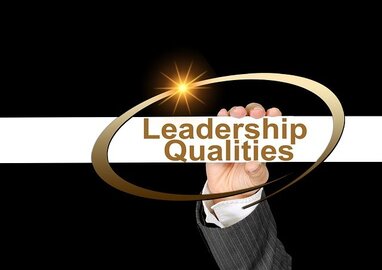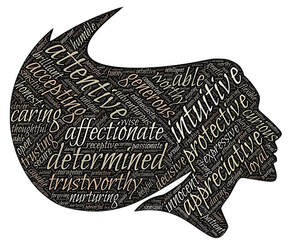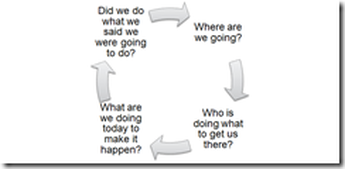 We all have the potential to become a leader, yet many fall short in developing their ability to become one or to reach beyond the status quo. There are a variety of reasons why this may be so ranging from not knowing what to do to sheer laziness in becoming the best that they can be as leader. If you want to develop your leadership abilities then the five points covered in this article may help you to overcome areas that may be holding you back. 1: Become a Follower. The heading of this topic may sound counterintuitive to you but consider this. There are potential leaders who view becoming a follower as something beneath them, whereas it is an essential quality for moving forward. There are few if any leaders in the world who have become one without the help and advice of other leaders. Excellent leaders have learned to be excellent followers in their development. Find yourself a mentor. Follow him or her around. Watch what they do and glean the positive elements of their actions. A leader-mentor is someone who has more experience than you, someone who you look up to and want to be like. Someone who shares your values, ethics and principles. A mentor will help you become focused and motivated; provide you with honest feedback; teaches you to problem solve and encourages your growth and development. You need not be ashamed to follow and be inspired by someone. You will learn much more than if you walk alone. It takes a bit of humility to follow someone, but if you don’t you will never have what is needed to guide others. Following a mentor also prepares you to become a mentor of other potential leaders. 2. Be A Continuous Learner. Make a point of nurturing a growth mindset. You can’t know everything, but you can become an expert in your field. And it is in this capacity that you will be trusted. Open your mind to not only learning the ‘hard technical skills’ in your area of expertise but also the ‘soft skills’ you will need to relate to others. Leadership is about engaging others to move forward, to follow a vision and to have others take action on a shared vision. In order to do that leaders need necessary soft skills to engage their followers. 3: Know your Values and Commit to them. Great leaders believe in firm positive values. Take the necessary time to uncover your values and then live and defend them. One of the major breakdowns among leaders is that they do not follow the values they preach. This is most unfortunate because followers become jaded, skeptical and seek to remove themselves as a follower. Here are five key values of successful leaders.
4. Become a Public Speaker One of the most stressful and difficult skills is to become a public speaker. Yet if you want to become a leader you must acquire the ability to speak in front of an audience. There is no doubt that public speaking can indeed be stressful, and even scary, but it’s a habit you have to get into. Public speaking can be learned through practice as many have witnessed, for instance:
5. Passionately Adhere to Your Vision Spend the necessary time in cultivating your vision – where you would like to be. Followers follow a leader with vision. It has been said that most people like to be led but they only follow leaders who are passionate about their vision. In the process of leading with passion be yourself rather than being like someone else. Let your authenticity shine through your actions and continually act with integrity. These five steps alone will not make you a leader, but if you master them you will be on your way to become one. A measure of a good leadership is the ability to influence, thus by following these five steps you will learn what it takes to influence others. Thank you for reading and as always take care, be safe and become the best version of yourself. Richard Fontanie Resource: Become A Leader: Find the Leader Within You. Type in “Leader” in the search bar on the Front Page at www.fontaniemagazine.com and you will find 94 references for leader and leadership.
0 Comments
 If you were to build a house, you would begin with a blueprint. This blueprint proves useful because it contains more than directions on how to build a house. It also describes the finished house. So, what does this have to do with leadership? Recently a colleague of mine asked an audience of leaders to tell him the characteristics of an ideal leader. Their answers were (in the order collected): A good listener, enthusiasm, passion, shows appreciation, a visionary, role model, trusting, integrity, organized, knowledgeable, credibility, persuasive, charisma, team building, clarity of purpose, problem solver, attitude of service, leads by example, patience, willing to act without complete knowledge, understands followers, consistent, empowers other people, and adapts to change. I'll add that this is essentially the same list that I received from other audiences when I asked this question. From this comes some useful insight.
Actually, applying these characteristics requires more strength than not.
And that's interesting because many popular representations of leadership emphasize at least one of these "hard" characteristics. In fact, these characteristics are the refuge of those who lack the strength (or the skills) to apply the human side of leadership.
Would they list characteristics from the "soft" list or from the "hard" list? Could you become more effective by improving upon any of the "soft" characteristics? And how about the other leaders in your organization? Do they truly maximize human potential? People want leaders who treat them with genuine compassion, courtesy, and respect. They want leaders who help them become more successful. They want leaders who inspire them with a vision for a better world and show them how to go there. See also my articles on A Manager's "Soft Stuff" Is Their "Hard Stuff." and under the tab Leadership Qualities on the side bar Thank you for reading, Richard P. Fontanie (From a soon to be released e-book – How To Become An Influential Leader)  A note before reading. Shadows can reflect both positive and negative aspects of leadership. Shadows used in this article reflect the darker or negative side found in LeaderManager behaviour. In the article Workplace Culture I explored how the Shadow in the workplace affects workers and in Wellbeing under Spiritual Discoveries I linked the concept with our inner selves. This article explores the role of the leader or leadership team in removing the shadow. LeaderManagers need courage to bring the shadow out into the open and give people reason to hope, but that hope needs to become reality for the shadow to be lifted. When LeaderManagers bring the shadow to light they cut through the stereotypes, biases, myths and tensions found within a given community or society. In the process they promote change, and that change often has repercussions. From a socio-political perspective we see examples of the difficulty in speaking the ‘truth’ and the upheaval it generates. Take for example, the reactions Martin Luther King experienced in bringing the shadow of racism to the fore, or Mahatma Gandhi in freeing India from British rule, or Nelson Mandela in loosing the chains of apartheid in South Africa, or Agnes Macphail, the first woman elected to the Canadian Parliament, or Rosa Parks, who moved from the back of the bus to the front of the bus, or currently Pope Francis who has embarked on a renewal within the Vatican. Consider also that these men and women of courage achieved or are achieving societal or institutional change through peaceful means. However, most LeaderManagers are not societal change agents – they are the necessary force that guide change within the workplace or within local community organizations and institutions. They too need courage to speak the truth. What do these people do to lighten the darkness? Champion a new or renewed vision and engage workers and communities in the process. Often workers are kept in the dark as to where the organization is going and are just expected to do and not question. It’s like the manager of one organization I worked for who said, “It is not for us to question why. It’s for us to do and die.” A harsh statement if there ever was one. Needless to say workers in that organization were unhappy, disengaged and looked for a way out of the organization. A clearly stated vision engages workers around a sense of purpose with which they can align their own sense of purpose. When one’s sense of purpose is aligned with the organization, commitment, engagement and loyalty follow. Redesign structures which encourage collaboration and cooperation. Highly bureaucratic structures reflect stultified silos which are not conducive to people working effectively across boundaries. This came to my attention once again when I heard, “l don’t care what you say, I report to another VP.” Structures that encourage collaboration and cooperation are flat where employees understand their boundaries and where the boundaries don’t bind them in effectively working with others. Employees of flat organizations don’t hide within the silos they know that the vision of the organization can only be achieved by people working together for the benefit of the whole. Make processes fluid and open. In line with collapsed silos these LeaderManagers work at developing more open and fluid processes. Processes can either cause “red tape,” or encourage “green tape.” Rigid organizations usually have too much “red tape” which inhibit workers from effectively doing their job. “Red tape” occurs when the leadership team reacts to one-off or exceptional situations with new rules and regulations which in effect slows down the whole of the organization. It’s like one grain of sand in the inner workings of a time piece. The small grain slows the whole mechanism and on occasion even causes it to stop. The time piece works well when nothing gets in the way of the wheels of motion. So too organizations will work well and move forward when their processes are fluid allowing people to get on with their work. Open doors to a set of positive values. Such values could include compassion, joy and honesty. A compassionate workplace gives new meaning to work; a joyful workplace makes it a fun place to work; and an honest workplace opens the door for greater justice, trust and cooperation. Organizations have values whether they are stated or not. People who are sensitive to the vibes of an organization can feel its values. Now add to the mix the behaviour workers exhibit. They will reflect what the organization believes to be of value. The darker shadow always reflects negative values, the light always reflects positive values. Positive values are those that move an organization forward. These are the values that LeaderManagers must champion as they help organizations move out of the shadow. Find solutions to problems, not bigger problems. Problems always have a cause and an effect. Strong LeaderManagers go to the cause of the problem and find ways to solve it. In the process they don’t create bigger problems than the one they are attempting to solve. A concrete example of this occurred in a correctional centre where a problem occurred on the food serving line. About a month prior to the occurrence a certain food type was served that caused severe diarrhea among the inmates. They were promised that that food type would not be served again by the Director of Custody. Unfortunately he didn’t tell the cooks his promise. You guessed it. A month later the food type was on the menu. The inmates went on a sit-down strike. The custodial staff wanted to go into the cell block with clubs and shields, but the LeaderManager found a peaceful and more lasting solution. He sat down with the leaders of the inmate community and sorted out a solution that included bringing them into the kitchen and showing them what was available. The solution, extra baloney sandwiches. The problem was solved without causing a bigger problem. LeaderManagers find solutions without creating bigger shadows. Thank you for reading, Richard P. Fontanie Sherry Knight, my friend from Dimension 11 writes some advice for those thinking of moving up and taking a leadership role. She references Saskatchewan but the message may be applied you no matter where you live.
There are some things to consider when you are looking for your own future success. One of the most important is to recognize your own strengths and those areas where you want to be better than you already are. Sometimes when things go wrong you need to remind yourself that challenges can be fixed and you can fix the problem if you have the skills or you can find someone who can. Success is in your hands:
Know you can do it, do everything you can to make yourself a valuable part of your organization. Success is in your hands. From Knight Views. A Dimension 11 Publication. Find it here. Printed with permission. One of the great thought leader's of the past 50 years was Warren Bennis (d July 31, 2014). He wrote tirelessly on the topic of leadership. He was a sought after speaker, academic and coach. His book, "Leaders", coauthored by Burt Nanus and his classic "On Becoming a Leader" remain go-to literature on developing leadership strategies and building internal capacity for leadership. One of his early books "Changing Organizations" was instrumental in my initial understanding of organizational culture and change. His work on leadership was seminal in bringing the topic of leadership to the forefront. His clear and forthright writings helped me understand the relationship and balance between leadership and management and how I had both leadership and management responsibilities in the positions that I held. According to an article by Julie Kirby ( Harvard Blog Post), Bennis was thinking of writing another book which he would have called "Grace." He pointed out that he was not a particularly religious person, but that this word is very powerful. The book would deal with such issues as generosity, respect, redemption and sacrifices. He was quoted as saying: "All of which sound vaguely spiritual, but all of which I think are going to be required for leadership." And, I would say "not going to" but "are required for leadership, today." Powerful indeed! What a wonderful concept "Grace and Leadership." I think if we want to understand the meaning of the two we will need to go deep within ourselves - to reach a level of consciousness which goes beyond our egotistical self and gets to the core of who we are as a leader - or better, as a person with leadership qualities. We will need to touch our soul so to speak, and in so doing be graced with a transcendence beyond ourselves. This suggests placing our active mind at rest and spending more time in contemplation and meditation. To be sure, grace-filled leaders will experience internal struggles, maybe even darkness, and hardship. They may be misunderstood, maligned and viewed by some as too soft. They will be tested but being grace-filled their resolve will be strengthened to do the right thing for themselves and others. Yes, this does bring leadership into the realm of the spiritual world. From my vantage point it means transcending anything negative and focusing on that which is good and worthy. It's based on the principles of: 1) abundance and positiveness (relying on our innate nature to do good), 2) transcendence of self ( moving to a higher level of purpose with humility), and 3) personal discovery (finding a new way to bring the first two to fruition). The influence of grace-filled leaders will transform toxic and sick workplaces and communities to healthy and vibrant ones. In practical terms this suggests they will rally those around them to forge cultures- whether within or without their organizations - that exhibit compassion, justice, fairness, forgiveness, generosity, respectfulness, and integrity. To do this, however, they too will need to be perceived as compassionate, just, fair, forgiving, respectful, generous and one acting with integrity. And, their power will come from humble and selfless service rather than arrogant and egotistical behavior. My sense is that our troubled world and places of businesses need the wisdom and healing action of grace-filled leaders today. Fortunately we have proof of grace-filled leaders who can serve as role models for us. Think of Nelson Mandela and Bishop Tutu who promoted reconciliation rather than revenge, Gandhi and Martin Luther King who transformed countries through peaceful protest, and Pope Paul II who opened the doors for a free Poland through integrity and faith based discipline, and Paul Farmer, "an anthropologist and physician who is best know for his humanitarian work providing suitable health care to rural and under-resourced areas in developing countries" . Think of the countless community leaders who bring hope to the downtrodden, health to the underprivileged, and compassion to the homeless. Think of company leaders who promote ethical business practices, hold people to high standards and values and who contribute to the welfare of communities. Think of the artist leaders who share their talents, gifts and wealth. And think of parent leaders who teach their children to give rather than receive, to love rather than hate, to play to enjoy rather than to play to win at any cost. Grace-filled leaders are all around us and we can become one of them. I wish Warren Bennis lived long enough to write his book, I'm sure it would have been another classic. "Becoming a leader is synonymous with becoming yourself. It is precisely that simple, and it is also that difficult." Warren Bennis on "Becoming a Leader.' One of the advantages of working with many owners of small businesses is that I have the opportunity to compare the stronger ones with the weaker ones. By watching how they perform I can validate the importance of strong leadership and management practices. The way owners lead and manage successful businesses compared to those who struggle is often stark. The following is an example of the leadership and management practices of an owner of a successful business.
I met Terry over 20 years ago by way of referral from a business associate. He presently owns two automotive dealerships in a community with a population of less than 20,000 and serves a trading area of over 1400 square miles serving more than 150,000 people. His approach to leadership and management has developed over the years. Here's what I found about "Terry's Way." Strategic Planning: Terry involves his key people in planning and keeps control over the outcome. He spends time ensuring his business plan is current and uses it to keep his business on a growth trajectory. He has a measured approach to development and change and a clear understanding of his marketplace realities. Management Team: Terry surrounds himself with a strong management team who have well defined roles and responsibilities. He grew his team from within, and when talent and strength were lacking he attracted members from the wider community. Meetings: He holds regular management meetings. The meetings have agendas. Minutes, and decisions are recorded and are followed up after the meeting. Policy issues are discussed and the over-all activity of the company is monitored against the business plan. He holds general "State of the Business" sessions with his employees and ensures their concerns are heard first hand. He also makes sure his employees interact socially and encourages times for individual and business celebrations. Delegation: Terry has no trouble delegating important matters to his management team. He allows employees to make mistakes as long as they learn from them. When he delegates he doesn't interfere with how they carry out the action. Hiring: Job descriptions are well defined and employees are hired based on those job description requirements. Terry's main concern is that there is a proper fit between the person and the position. If there isn't a fit, he has no trouble moving the person to a better fit within the organization, or moving the person out where a more suitable fit may be found. Learning: Terry regularly reads business related books and articles. His books find their way to an in-house library of current business literature; and, he encourages employees to borrow them. He holds regular technical and people skill training sessions. He understands that the core of his business is all about promoting positive relationships and everyone within the organization needs to continually improve those skills. There are no exceptions including himself. He attends training sessions not only to sharpen his own skills but also to be a role model for ongoing learning. An important by-product of his attending training is, as he states: "to find ways to reinforce the training during the months following the training." He asks himself and others how training fits within the vision and values of his company and what results he should expect. Customers: Terry knows that customers come first in his business. Without them, he has no business. He has a "make it easy for the customer," mantra that permeates the business culture. One of my consulting firm's first interventions with Terry was to help him understand how his customers viewed his business and service. We did this through a series of customer focus groups. Terry and his key managers attended those sessions. To this day, Terry continues to glean feedback from his customers through a formal follow-up process and by meeting with them first hand. It's not that he doesn't receive "customer service complaints" but it is his approach to those complaints that is important. He sees them as an opportunity to "do better," and as he says, "we're here to fix what isn't working and make it right." Technology and Systems: The auto industry has experienced tremendous technological advances since the 1980s, and Terry's Service Department has kept pace with the challenge. But technology has not only affected the way cars and trucks work, it also has impacted the way business systems and processes work. He has developed an improved automated Customer Relations Management system and a more effective use of Microsoft Outlook through the Priority Working Sm@rt program. Terry sees the importance of keeping current with changes in technology hardware and the software that goes along with it. Terry is first to admit that his business doesn't always run like clockwork, in fact he is sure it never has. No business does. They all have emerging people or technical issues in search of solutions. What's important is that Terry is open to learning, and change and does what is necessary to "fix" the problems as they arise, and does what he can to prevent them from occurring in the first place. By now you get a sense that Terry is a successful business owner and a leader-manager. His business has grown over the years, kept pace with changes, and developed a loyal customer and employee base. He has improved business systems and processes through a continued learning and application. He has kept his employees current with best practice technological and people skills. He is an authentic, unassuming, and supportive leader who is well respected within his company and throughout his community. He, with the support of his employees, has received numerous industry and community awards and citations. This is one example of proof that strong leadership and management works. Questions to Ponder: How well do you lead and manage? Do you have a business plan? Do you work the plan? Does your management team show both leadership and management qualities? Do you hire the right people? Have you encouraged a culture of learning, respect and growth? Do you know what your customers say about your business? How do you know? Is your technology current? Are your systems and processes effective? How do you know? The right answers to these questions will put your business on the road to success. They are worth exploring, begin seeking the answers today. Up-dated from the Archives of Fontanie Learning Solutions. All leaders reflect a certain style or behavioural profile from which others begin to describe them. Some are directive and take bold action, others are charismatic and engaging collaborators, others are more methodical and circumspect, while others are agreeable and people focused. Spring is as a good time as any to revisit your leadership style and review how you may be projecting your leadership behaviors.
A leader is involved in three broad areas of work: crafting a vision, influencing others to align with that vision, and championing its execution. Understanding the link between your leadership style and the work you do as a leader will help you adjust to the differing circumstances each of these three areas bring. Let's take a brief look at the four leadership styles. The Directive Leader: The directive leader is action oriented and moves people to get things done. The danger signs exhibited by an overly directive leader is impatience, insensitivity and lack of concern for others. In their haste in getting things done this type of leader may tend to override others, and blame others because things are not going fast enough. Directive leaders may also push people to the extent that they feel high levels of anxiety and stress which may result in a reduction of overall productivity. Directive leaders can craft bold and dynamic visions but may have difficulty in bringing others in alignment with that vision and miss the nuances that are important when working with people as they execute the vision. The Analytical Leader: These leaders like to delve into detail, and sometimes have difficulty seeing the forest for the trees. They may have a hard time articulating a vision because they see too many options and as a result may have a tendency to constantly change direction. Analytical leaders are usually cautious and like to think things through. However, their tendency to be methodical and attention to detail may give the impression that their vision is the 'only one" and the "right" one. They enjoy the intellectual challenge of crafting a vision and engaging others in aligning the vision. However, they may fall short in overseeing the execution of the plan because they may pay too much attention to detail or procrastinate too long. The Fitting-in Leader: A third leadership profile sees leaders wanting to fit in with the group or team. They are usually friendly, supportive, collaborative and prone to build stable environments. Their vision is one of a calm organization where people are collaboratively working together in a cooperative environment. Alignment around the vision is key for them and they work hard to harmonize differing points of view so that there is a consistent and an aligned direction. They also seek a collaborative and coordinated effort in the execution of the plan. The watch-phrases for these types of leaders are over accommodating, maintaining stability when flexibility is required and fearing ambiguity and risk when action is necessary. The Outgoing Leader: This type of leader is one who is outgoing, relational and highly communicative. This leader likes to network, work the phone, bring people together both socially and corporately. They are usually excellent at influencing others and selling ideas. They have a certain charm and enthusiasm about them and exhibit a sense of optimism. They can also be impulsive and disorganized. They are expansive visionaries, and tend to enthusiastically influence others to buy into their vision and excel in keeping others abreast as the plan moves to execution. Their strength ensures high levels of communication but their weaker tendencies could cause disorganization especially if they act impulsively. Can you identify the leadership tendencies in Donald Trump, Justin Trudeau, Hilary Clinton, Barack Obama, Nelson Mandela, Mother Theresa, George W Bush, Pope Francis, Angela Merkel, Jimmy Carter, and Bill Clinton? Each has a predominate style that reflects the profiles outlined above. If you can pick out the style of these leaders you can see it in others as well as your own. There is no right or wrong leadership style. The leader goes amiss when he or she pushes the extremities of the style as when the directive leader becomes over dictatorial, the analytical leader becomes paralyzed in analysis, the fit-in leader becomes part of the group rather than the leader of the group, or the out-going leader becomes too friendly or overly impulsive. The good news is that most leaders have qualities which reflect several of the behaviors identified in each of the profiles above. They are a composite, yet a predominant profile emerges whether that be directive and dictatorial, relational and communicative, quiet and collaborative, or cautious and analytical. All strong leaders have a sense of confidence, know themselves well and use their strengths to advance their vision, align others around that vision and execute the vision through others while exercising their predominant profile. Questions to Ponder: As you move into spring is it time to think about your approach to leadership; how do you tend to lead? Can you identify with one of the profiles above? What strengths and weaknesses do you bring to your organization? What quirks do you need to watch out for? What modifications do you need to make in your approach? Do you use your leadership style to meet others' needs, or do you use it to meet your own needs? If you want to learn more about assessing you leadership profile let us know.  It is often said that simplicity is the hallmark of a genius. Strong leaders take complex concepts and boil them down to a simple statement or formula that provides the basis for understanding. Now I don’t pretend to be a genius, far from it, but I have found that there are four simple questions leaders need to ask. 1) Where are we going? The answer to this question lies in the organization's vision, mission, goals, and measurable objectives. Without these statements no one is sure where the organization is headed. We have witnessed numerous occasions where management and staff ran around in circles and operated with sheer frustration when they were unclear about the overall direction of the organization. 2) Who is doing what to get us there? Once the management team knows where the organization is going it is ready to work on designing an effective organizational structure. This includes detailing various roles, responsibilities, accountabilities, Job descriptions and specific work objectives to get the job done. With these in place, work is now structured to accomplish an end and everyone within the organization should know what to do and where they fit. 3) What are we doing today to make things happen? We will never get to our destination unless we make something happen. So clarifying daily, weekly and monthly tasks and priorities to accomplish the work is absolutely necessary. By keeping to task we make things happen. 4) Did we accomplish what we set out to do? The old dictum “you can’t improve unless you measure.” is true today as it was when it was first uttered. The leadership team requires relevant data to evaluate how well and how much was accomplished during the period under review. By keeping score and having the appropriate data it can answer the question: "Did we do what we said we were going to do?" What to do: Before something runs amok in your organization ask: Do we know where we are going? Are we clear about who is doing what? Are we focused on achieving results on a regular basis? Do we have the tools in place to measure results? Want to learn more? Mark Light has an interesting book entitled “The Strategic Board.” He fleshes out these four questions in greater detail from a board leadership perspective. Simplicity is the ultimate sophistication." Leonardo daVinci Author: Richard P. Fontanie, MSW. FCMC
Image from Fontanie Archives  Workplaces "are a-changin" to borrow a phrase from Bob Dylan's title song "The Times They Are a -Changin". When we think about it, hasn't change always been with us? Every generation sees a shift in how we build and relate to each other. I think of my father, a mechanic, who worked on the Model T and Model A Ford and advanced to vehicles with sleek designs, automated transmissions, travelled farther, faster and with greater efficiency which could only be a dream back in the 1920s. Change in the automotive industry was constant. He also witnessed massive changes in the social order, having lived through two world wars, the impact of coming of television and the spread of the entertainment industry, the exploration of space, the advancement in education and the dawning of the computer and the information age. Massive changes these were. All affected the way we work, play and relate to one another. Yes the times were "a-changin." And they still are. However some things don't change. These are the legacy of great leaders of the past who can continue to inspire today's workplace leaders. What I find as we move from one generation to another is how successful companies were and are open to change, both on the technical and socio-cultural sides of the business. They understand the "yin and yang" of business. This means attracting leadership that continuously advance products and services but also can inspire loyalty, commitment, and fervor in the workplace. In today's workplace what are the qualities leaders need to do this? I suggest they are the same ones that have marked the leaders of the past. However, I think we need these qualities more than ever today. Leaders keep employees when they: Have Integrity. Leaders with integrity practice what they say or "walk the talk" as the saying goes. They walk with consistency, honesty, trustworthiness, and moral up rightness. They hold themselves to high ethical standards and deal with others with respect and dignity. One of the greatest compliments one can give a leader is to say, “Her/his actions show he/she has integrity.” Show Gratitude. Great leaders count their blessings and understand they are leaders only because they have followers. Without followers who do they lead? Their gratefulness is exhibited through a strong sense of appreciation for those who work for them and with them. They are humble when they receive praise and point to those around them who help them achieve the company's vision and goals. Champion Values. Great leaders clothe themselves in the values and principles that guide the organization. Too many businesses spend time mapping out their values and then the leaders fail to champion them. One of the most demoralizing behaviours within organizations occurs when people see their leaders contradict the values everyone is expected to up-hold. Leaders can only champion values if their behaviour is consistent with those values. Championing living values goes hand in hand with integrity. Encourage Participation. Great leaders understand that the way to achieve commitment to goals and strategies is to engage participants in determining what action to take to make them come alive. This requires strong influencing and communication skills. They encourage employee participation in the planning process and those expectations that affect them. Great leaders don't say "Do this and that!" Rather they say "How do you think we should do this or that?" They are consultative rather than directive; however, they can be directive when the need arises such as in an emergency or crises situation. Even in a crisis though they often call upon their key advisers to discuss options. Sometimes business leaders can be mini-dictators, and when they are they primarily operate by creating fear. Great leaders don't lead with fear but inspire with hope, encouragement and engagement. Take Time to Listen. The art and skill of listening is a lifelong challenge for some, but for great leaders they are a necessary attribute. Great leaders don't close their ears to receiving new ideas, ways to improve, the story of a troubled employee, or, a plea for help to solve a problem. They are empathetic listeners who try to understand the context of a problem, issue, or employee difficulty and engage those affected in determining a solution. An empathetic listener may not have to say anything, but evidences that h/she is listening. The point here is that great leaders take time to listen before they act or encourage others to act. Promote Continuous Learning. Great leaders are open to continuous learning. They are eager to challenge their own thinking and not afraid to change a course of action or learn from both mistakes and successes. In today's business world great leaders know that the only way to keep ahead of the curve is to continuously improve people, processes, products and services. They identify as a priority training dollars for both technical and transferable skills during economic up-swings and down-swings. It takes courage for leaders to protect training dollars during economic down turns particularly in a culture where employee training is viewed as an expense rather than as an investment in the growth and regeneration of companies. Lead Without Micromanaging. Great leaders know how to delegate and then get out of the way. Leaders who micromanage become the thorn in the side of those whose responsibility it is to carry out that which has been delegated. Leaders who micromanage have difficulty in letting go, they want to be 'doers' rather than leaders. Leaders set the boundaries for the delegated responsibility: they clearly state what they are delegating, put the matter into context for the delegatee, identify when the matter is due, hand over the responsibility to get the job done, and then get out of the way. When the matter is completed they review process and outcomes with the delegatee; and, if there are problems along the way, they engage the delegatee in finding solutions rather than providing solutions. If the person doesn't carry out the responsibility, then the leader needs to understand why. If it is because the person doesn't have the skills then a teaching moment presents itself; if it is because the person doesn't want to do it, is a procrastinator, or other factors are in the way, then a performance coaching session presents itself. Whatever the situation, great leaders divest themselves of micromanaging and arm themselves with managing the behavioural issues surrounding the delegated task. Do the Usual Things Well. When the normal functions of an organization work well, great leaders stand back. To get to that level they ensure the usual requirements of the organization are done well. They put in place appropriate policies and review those that are outdated and make changes where necessary, follow sound hiring practices and lead the marketplace with better salaries and benefits. In short, they hire the best and pay them well. They continually promote process and operational improvement strategies; ensure technological tools are current; keep products and service relevant; scan the marketplace environment and adjust their market and sales strategies accordingly; and keep sound stewardship over all their resources. Yes, they do the usual things well. Show Compassion. Great leaders are compassionate people. They are contributors to their communities in several ways. They encourage employees to become involved in extending themselves to those less fortunate. Examples abound in our community alone where leaders donate portions of their profits to contribute to such causes as the Food Bank, Habitat for Humanity, Head Start schools, University expansion, United Way, hospital expansion, libraries, health research, and scholarship funds, to name a few. They also encourage employees to contribute in a direct way with food drives, fund raising, and volunteering. Great leaders have learned that in "giving" they "receive." Celebrate and Socialize. Great leaders understand that it is not always work that counts. They encourage employees to celebrate achievements both from a business and a personal perspective. They promote opportunities for company socialization to bolster camaraderie and team spirit. Sometimes they combine these with learning events or office retreats; often they are promoted as a recognized dimension of the corporate culture. Lessons Learned: Change has always been part of growth and development. Without it we stand still. And when we stand still we start to go downhill and growth atrophies. Great leaders understand this. They also understand that employees want to work in a place that is alive with enthusiasm and joy. They know how to engender loyalty, even in a time when research indicates that employee loyalty is waning. They know that exhibiting personal integrity, living strong personal and company values, showing gratitude, listening deeply and being compassionate are the intangibles that make a difference in the workplace. They are also confident that the way to foster loyalty is to encourage engagement and participation, make sure all the usual things are done well, delegate without micromanaging, view learning as a necessary adjunct to personal and corporate growth, and celebrate and foster socialization within the workplace. If you want to become a great leader check how well you are acting on these attributes and develop a strategy where you think you can improve. Author: Richard P. Fontanie, MSW, FCMC Up-dated from Fontanie Leaning Solutions. Note: Image from Freedigitalphotos.net |
Categories
All
Archives
January 2024
|
Photo from CityofStPete


 RSS Feed
RSS Feed

